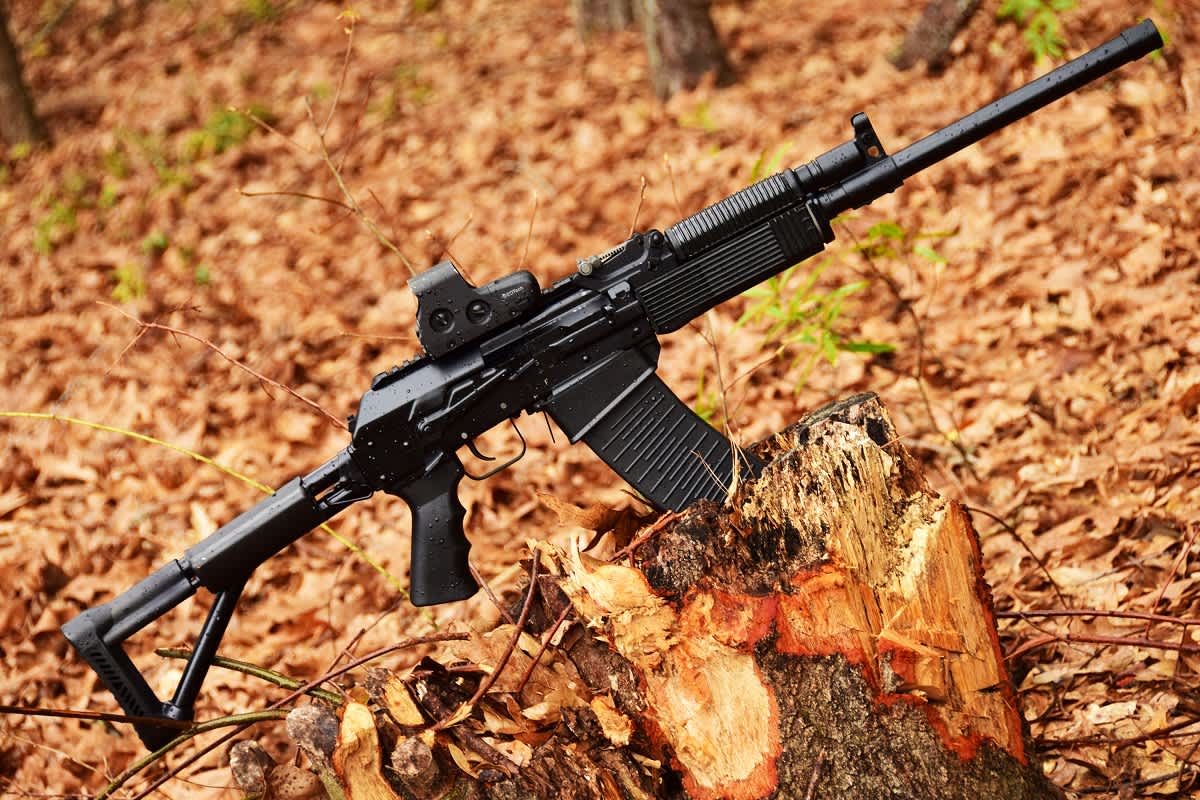Vepr 12 Shotgun
Jim Grant 04.06.15

Few things are as awe-inspiring as detachable magazine-fed shotguns. They’re the firearm equivalent of rocket-powered speedboats. Adding a detachable mag to a buckshot-slinging manstopper cranks the gun up to 11—at least theoretically. Sadly, most mag-fed scatterguns are too ammunition-sensitive to be considered for serious use. Of the reliable few remaining, the majority are either too expensive or rare for most shooters to own. Thankfully, Molot of Russia lets shooters go hog wild with their porcine shotgun, the 12 gauge Vepr 12.
The Vepr (which stands for “wild boar” in Russian) line is a series of autoloading firearms manufactured at the Molot-Oruzhie plant in Vyatskiye Polyany, Russia. Based on the RPK light machine gun variant of the Kalashnikov, Veprs are highly praised for their durability and precise fitting. This ruggedness is aided in no small part by the firearms’ receiver walls, which are 50 percent thicker than Saiga and other “traditional” AK rifles. While Vepr rifles are available in common centerfire calibers like .308 and 7.62x39mm, the real crown jewel of the line is the Vepr 12 shotgun.
At first glance, the Vepr 12 (chambered for 2-3/4- and 3-inch shells) looks like a “Saiga 12” shotgun converted to take traditional AK furniture. The features that separate it from the Saiga aren’t simply cosmetic, they greatly affect the gunn’s usability and functionality. Most of these changes are directly influenced by popular user modifications for the Saiga. For example, the Vepr does away with the traditional straight stock and exposed gas tube of the Saiga in favor of more AK-like polymer furniture.

Additionally, the Vepr utilizes a custom grooved pistol grip made exclusively by Molot which better facilitates use of its ambidextrous safety lever. Another cool feature is the inclusion of an RPK-style rear sight adjustable for windage and drop. Paired with a V2-style straight gas-block front sight, the Vepr looks more menacing than the wild boar it’s named after.
Of all the improvements that Vepr has over the Saiga shotgun, two in particular stand above the rest, making this Russian autoloader better suited to both combat and competition. The first is a polymer magazine well that helps expedite reloads, especially under stress. The second is a built-in bolt release that is as simple as it is effective.
How so? On Vepr shotguns, the magazine follower assists in locking the bolt back on an empty gun. The release does double duty—it not only releases the bolt from a sear catch, it also depresses the inserted magazine’s follower. Simple, yet effective. What’s revolutionary is its location. Situated on the right side of the bottom of the receiver, adjacent to the trigger, the bolt release allows shooters to chamber a round without changing their grip. It makes for a very user-friendly setup on a platform that’s typically known for its rough ergonomics.
A common feature on other semiautomatic shotguns that the Vepr unfortunately lacks is an adjustable gas system. Described as self-regulating, the Vepr’s gas tube ports are designed to vent unnecessary pressure while providing sufficient force to cycle the action. While my test gun ran with all types of ammo tested ranging from birdshot and sporting loads to slugs and military buckshot, I would still prefer the ability to dial the gun for my desired load.
The Vepr’s 18-inch barrel is topped with a thread protector on the muzzle. While not threaded for traditional chokes, the external threading allows the use of both Saiga- and Vepr-specific adapters. This includes chokes, compensators, flash-hiders, and, most recently, suppressors.

So the Vepr has an exhaustive list of desirable features, but how does it actually perform? I’ve owned my Vepr 12 for around a year. In that time, I’ve shot approximately 400 zinc slugs, 200 rounds of buckshot, and 800 rounds of various target loads through it. During this course of fire, I encountered roughly a dozen malfunctions. All but two were within the first 50 rounds fired. After that brief break-in period, the gun performed great.
The magazine provided with the gun holds five 12 gauge shells, but larger aftermarket magazines exist in capacities ranging from four to 25 shells. While Molot-made magazines are awesome, they are expensive and can be difficult to find. The best aftermarket magazines I’ve used yet are the steel-bodied eight-round mags from CSSpecs. These American-made magazines are much heavier than the original polymer ones, but are around $20 cheaper than factory magazines and, for shooters trying to meet 922(r) compliance, count as three US-made parts.

Accuracy with any shotgun is more about patterning than precision. The included iron sights on the Vepr 12 leave much to be desired, as they are the miniscule post and notch variety found on AK rifles. Thankfully, the Vepr has a hinged, railed dust cover that allows users to mount red dot and holographic sights. Unlike traditional AK rifles, the dust cover on the Vepr is permanently secured, so the gun’s zero doesn’t drift during fire. A cheek rest fitted to the skeleton-style stock helps facilitate a solid sight picture.
While its MSRP is just south of $1,000, the Vepr 12 can be found online for hundreds less. This makes the Vepr an affordable, viable home-defense gun that offers infinitely faster reloads than traditional shotguns. Shooters looking for a fun range toy, reliable self-defense tool, or open division 3-gun shotgun should look no further than the Molot Vepr 12, now being imported by Wolf Performance Arms, Ammunition, and Optics.

